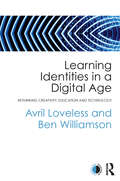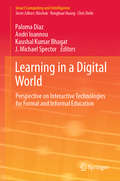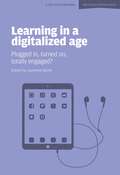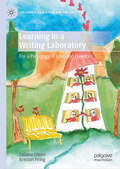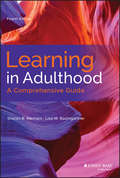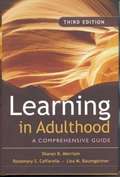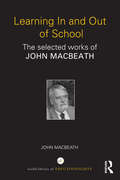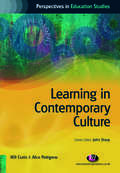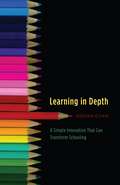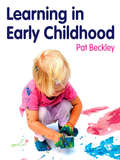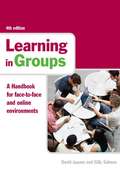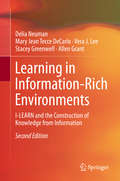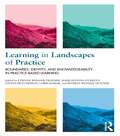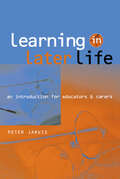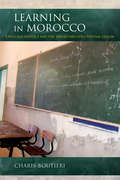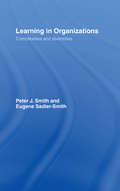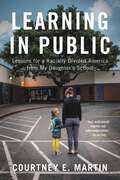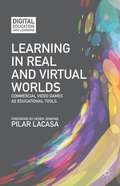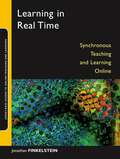- Table View
- List View
Learning Identities, Education, and Community
by Erstad, Ola and Gilje, Øystein and Sefton-Green, Julian and Arnseth, Hans Christian Ola Erstad Øystein Gilje Julian Sefton-Green Hans Christian Arnseth"This book offers a case study of children and young people in Groruddalen, Norway, as they live, study and work within the contexts of their families, educational institutions and informal activities. Examining learning as a life-wide concept, the study reveals how 'learning identities' are forged through complex interplays between young people and their communities, and how these identities translate and transfer across different locations and learning contexts. The authors also explore how diverse immigrant populations integrate and conceptualize their education as a key route to personal meaning and future productivity. In highlighting the relationships between education, literacy and identity within a sociocultural context, this book is at the cutting edge of discussions about what matters as children learn"--
Learning Identities in a Digital Age: Rethinking creativity, education and technology (Changing Times In Education Ser.)
by Avril Loveless Ben WilliamsonDigital media are increasingly interwoven into how we understand society and ourselves today. From lines of code to evolving forms of online conduct, they have become an ever-present layer of our age. The rethinking of education has now become the subject of intense global policy debates and academic research, paralleled by the invention and promot
Learning in a Digital World: Perspective on Interactive Technologies for Formal and Informal Education (Smart Computing and Intelligence)
by Paloma Díaz Andri Ioannou Kaushal Kumar Bhagat J. Michael SpectorThis book aims at guiding the educators from a variety of available technologies to support learning and teaching by discussing the learning benefits and the challenges that interactive technology imposes. This guidance is based on practical experiences gathered through developing and integrating them into varied educational settings. It compiles experiences gained with various interactive technologies, offering a comprehensive perspective on the use and potential value of interactive technologies to support learning and teaching. Taken together, the chapters provide a broader view that does not focus exclusively on the uses of technology in educational settings, but also on the impact and ability of technology to improve the learning and teaching processes.The book addresses the needs of researchers, educators and other stakeholders in the area of education interested in learning how interactive technologies can be used to overcome key educational challenges.
Learning in a Digitalized Age: Plugged in, Turned on, Totally Engaged? (World Class Schools Ser.)
by Lawrence BurkeAll professional learning communities agree that there is added value in utilizing technologies to enhance and facilitate student success. This volume seeks from us a critical and informed answer to one of the most important educational questions of the day: how successful will learners be in the digital age? Here, writers with real hands-on experience in the field challenge many of the assumptions about teaching and learning in the digital age. It is relevant and important for all those interested and concerned about the kinds of debates, arguments and ideas which are influencing and changing the nature of teaching and learning in the early decades of the 21st century.
Learning in a Digitalized Age: Plugged in, Turned on, Totally Engaged? (World Class Schools Ser.)
by Lawrence BurkeAll professional learning communities agree that there is added value in utilizing technologies to enhance and facilitate student success. This volume seeks from us a critical and informed answer to one of the most important educational questions of the day: how successful will learners be in the digital age? Here, writers with real hands-on experience in the field challenge many of the assumptions about teaching and learning in the digital age. It is relevant and important for all those interested and concerned about the kinds of debates, arguments and ideas which are influencing and changing the nature of teaching and learning in the early decades of the 21st century.
Learning in a Writing Laboratory: For a Pedagogy of Love and Freedom (Creativity, Education and the Arts)
by Tatiana Chemi Kristian FiringThis book is an exploration of a collective writing laboratory designed to stimulate creativity and critical reflection for education professionals. The authors uncover how a writing lab can help educators develop their teaching practices and identities by means of critical-creative, collaborative, relational and arts-based methodologies. A theoretical insight into pedagogies of love and freedom illustrating how laboratory practices in education can become acts of daily care, the book will appeal to students and scholars of education, arts-based methods and creativity.
Learning in Adulthood: A Comprehensive Guide (Wiley Desktop Editions Ser.)
by Sharan B. Merriam Lisa M. BaumgartnerThe new edition of the authoritative book in the field of adult education — fully revised to reflect the latest research and practice implications. For nearly three decades, Learning in Adulthood has been the definitive guide in the field of adult education. Now in its fourth edition, this comprehensive volume is fully revised to reflect the latest developments in theory, research, and practice. The authors integrate foundational research and current knowledge to present fresh, original perspectives on teaching and learning in adulthood. Written by internationally-recognized experts, this market-leading guide draws from work in sociology, philosophy, critical social theory, psychology, and education to provide an inclusive overview of adult learning. Designed primarily for educators of adults, this book is accessible for readers new to adult education, yet suitably rigorous for those more familiar with the subject. Content is organized into four practical parts, covering topics such as the social context of adult learning, self-directed and transformational learning, postmodern and feminist perspectives, cognitive development in adulthood, and more. Offering the most comprehensive single-volume treatment of adult learning available, this landmark text: Offers a wide-ranging perspective on adult learning Synthesizes the latest thinking and work in the field Includes coverage of the sociocultural perspectives of adult learning Explores the broader social implications of adult education Learning in Adulthood: A Comprehensive Guide, 4th Edition is an indispensable resource for educators and administrators involved in teaching adults, as well as faculty and students in graduate programs in adult education.
Learning in Adulthood: A Comprehensive Guide (3rd Edition)
by Sharan B. Merriam Rosemary S. Caffarella Lisa M. Baumgartner"This third edition of Learning in Adulthood is substantially reorganized from the previous edition. This edition is divided into four parts. Part One describes the context of adult learning. Part Two focuses on theories and models of adult learning. The chapters in Part Three address newer approaches to adult learning, and those in Part Four present material on topics that intersect with adult learning, such as memory and cognition, adult development, and so on.
Learning In and Out of School: The selected works of John MacBeath
by John MacBeathIn the World Library of Educationalists series, international experts themselves compile career-long collections of what they judge to be their finest pieces - extracts from books, key articles, salient research findings, major theoretical and practical contributions - so the world can read them in a single manageable volume.John MacBeath has spent
Learning in Contemporary Culture (Perspectives in Education Studies Series)
by Will Curtis Alice PettigrewThis book provides an accessible undergraduate-level introduction to the central educational concepts of learning and culture. In examining these themes it addresses key issues including: what is meant by ′culture′; characteristics commonly associated with contemporary culture; relationships between culture and learning; changing understandings of how, what, where and when we learn; the relationship between learning, national identity and citizenship; and the impact of all these on our way of life today. These ideas are approached from historical, philosophical, sociological, political and psychological perspectives: the traditional disciplines of Education Studies.
Learning in Depth: A Simple Innovation That Can Transform Schooling
by Kieran EganFor generations, schools have aimed to introduce students to a broad range of topics through curriculum that ensure that they will at least have some acquaintance with most areas of human knowledge by the time they graduate. Yet such broad knowledge can’t help but be somewhat superficial—and, as Kieran Egan argues, it omits a crucial aspect of true education: deep knowledge. Real education, Egan explains, consists of both general knowledge and detailed understanding, and in Learning in Depth he outlines an ambitious yet practical plan to incorporate deep knowledge into basic education. Under Egan’s program, students will follow the usual curriculum, but with one crucial addition: beginning with their first days of school and continuing until graduation, they will eachalso study one topic—such as apples, birds, sacred buildings, mollusks,circuses, or stars—in depth. Over the years, with the help and guidance of their supervising teacher, students will expand their understanding of their one topic and build portfolios of knowledge that grow and change along with them. By the time they graduate each student will know as much about his or her topic as almost anyone on earth—and in the process will have learned important, even life-changing lessons about the meaning of expertise, the value of dedication, and the delight of knowing something in depth. Though Egan’s program may be radical in its effects, it is strikingly simple to implement—as a number of schools have already discovered—and with Learning in Depth as a blueprint, parents, educators, and administrators can instantly begin taking the first steps toward transforming our schools and fundamentally deepening their students’ minds.
Learning in Depth: A Simple Innovation That Can Transform Schooling
by Kieran EganFor generations, schools have aimed to introduce students to a broad range of topics through curriculum that ensure that they will at least have some acquaintance with most areas of human knowledge by the time they graduate. Yet such broad knowledge can’t help but be somewhat superficial—and, as Kieran Egan argues, it omits a crucial aspect of true education: deep knowledge.Real education, Egan explains, consists of both general knowledge and detailed understanding, and in Learning in Depth he outlines an ambitious yet practical plan to incorporate deep knowledge into basic education. Under Egan’s program, students will follow the usual curriculum, but with one crucial addition: beginning with their first days of school and continuing until graduation, they will eachalso study one topic—such as apples, birds, sacred buildings, mollusks,circuses, or stars—in depth. Over the years, with the help and guidance of their supervising teacher, students will expand their understanding of their one topic and build portfolios of knowledge that grow and change along with them. By the time they graduate each student will know as much about his or her topic as almost anyone on earth—and in the process will have learned important, even life-changing lessons about the meaning of expertise, the value of dedication, and the delight of knowing something in depth.Though Egan’s program may be radical in its effects, it is strikingly simple to implement—as a number of schools have already discovered—and with Learning in Depth as a blueprint, parents, educators, and administrators can instantly begin taking the first steps toward transforming our schools and fundamentally deepening their students’ minds.
Learning in Doing: Constructing Dynamic Triangles Together
by Gerry StahlRational thinking as exemplified in mathematical cognition is immensely important in the modern world. This book documents how a group of three eighth-grade girls developed specific group practices typical of such thinking in an online educational experience. A longitudinal case study tracks the team through eight hour-long sessions, following the students' meaning-making processes through their mutual chat responses preserved in computer logs coordinated with their geometric actions. The examination of data focuses on key areas of the team's development: its effective team collaboration, its productive mathematical discourse, its enacted use of dynamic-geometry tools, and its ability to identify and construct dynamic-geometry dependencies. This detailed study of group cognition serves as a paradigmatic example of computer-supported collaborative learning, incorporating a unique model of human-computer interaction analysis applied to the use of innovative educational technology. A valuable resource for researchers, instructors, and students alike, it offers concrete suggestions for improving educational practice.
Learning in Early Childhood: A Whole Child Approach from birth to 8
by Pat BeckleyBy explaining the theoretical context and highlighting relevant research evidence, this book supports a whole child approach to learning in the early years. Drawing on case studies from a wide range of early years settings, the chapters consider how the different professions in education, health and social care can work together to achieve the best possible outcomes for all young children. Included are chapters on: ·theories of learning ·partnerships with parents and carers ·motivation and self-esteem ·diversity ·inclusion ·thinking skills ·approaches to play ·engaging early learners ·leadership and management ·multi-agency working The links made between theory and practice, and the practical suggestions for how to make this happen in any early years setting, make this book a vital text for all early years students.
Learning In The Fast Lane: 8 Ways To Put All Students On The Road To Academic Success
by Suzy Pepper RollinsToo often, students who fail a grade or a course receive remediation that ends up widening rather than closing achievement gaps. According to veteran classroom teacher and educational consultant Suzy Pepper Rollins, the true answer to supporting struggling students lies in acceleration. In Learning in the Fast Lane, she lays out a plan of action that teachers can use to immediately move underperforming students in the right direction and differentiate instruction for all learners—even those who excel academically. This essential guide identifies eight high-impact, research-based instructional approaches that will help you <p><p> * Make standards and learning goals explicit to students. <p> * Increase students' vocabulary—a key to their academic success. <p> * Build students' motivation and self-efficacy so that they become active, optimistic participants in class. <p> * Provide rich, timely feedback that enables students to improve when it counts. <p> * Address skill and knowledge gaps within the context of new learning. <p> Students deserve no less than the most effective strategies available. These hands-on, ready-to-implement practices will enable you to provide all students with compelling, rigorous, and engaging learning experiences.
Learning in Groups: A Handbook for Face-to-Face and Online Environments
by David Jaques Gilly SalmonLearning in groups, rather than in formal lectures or presentations, allows students to have greater scope to negotiate meaning and express themselves and their own ideas. It also helps them to establish far more effective releationships, not only with their tutors and trainers but with each other. Yet many tutors and trainers find the leadership role required when working in groups difficult to perform satisfactorily and revert to their traditional role as subject expert and prime talker. This handbook is a truly comprehensive guide for anyone involved in groupwork, containing advice and practical exercises to develop group learning skills for both learners and tutors. This new edition has been thoroughly updated, containing valuable new material throughout on group learning and collaborating online, action research and the role of reflection and emotional intelligence.
Learning in Information-Rich Environments
by Delia NeumanThe amount and range of information available to today's students--and indeed to all learners--is unprecedented. Phrases like "the information revolution", "the information (or knowledge) society", and "the knowledge economy" underscore the truism that our society has been transformed by virtually instantaneous access to virtually unlimited information. Thomas Friedman tells us that "The World Is Flat" and that we must devise new political and economic understandings based on the ceaseless communication of information from all corners of the world. The Bush administration tells us that information relating to the "war on terrorism" is so critical that we must allow new kinds of surveillance to keep society safe. Teenage subscribers to social-computing networks not only access information but enter text and video images and publish them widely--becoming the first adolescents in history to be creators as well as consumers of vast quantities of information. If the characteristics of "the information age" demand new conceptions of commerce, national security, and publishing--among other things--it is logical to assume that they carry implications for education as well. In fact, a good deal has been written over the last several decades about how education as a whole must transform its structure and curriculum to accommodate the possibilities offered by new technologies. Far less has been written, however, about how the specific affordances of these technologies--and the kinds of information they allow students to access and create--relate to the central purpose of education: learning. What does "learning" mean in an information-rich environment? What are its characteristics? What kinds of tasks should it involve? What concepts, strategies, attitudes, and skills do educators and students need to master if they are to learn effectively and efficiently in such an environment? How can researchers, theorists, and practitioners foster the well-founded and widespread development of such key elements of the learning process? This book explores these questions and suggests some tentative answers. Drawing from research and theory in three distinct but related fields--learning theory, instructional systems design, and information studies--it presents a way to think about learning that responds directly to the actualities of a world brimming with information. The book is grounded in the work of such key figures in learning theory as Bransford and Anderson & Krathwohl. It draws on such theorists of instructional design as Gagne, Mayer, and Merrill. From information studies, it uses ideas from Buckland, Marchionini, and Wilson (who is known for his pioneering work in "information behavior"--that is, the full range of information seeking and use). The book breaks new ground in bringing together ideas that have run in parallel for years but whose relationship has not been fully explored.
Learning in Information-Rich Environments: I-LEARN and the Construction of Knowledge from Information
by Delia Neuman Mary Jean Tecce DeCarlo Vera J. Lee Stacey Greenwell Allen GrantThe amount and range of information available to today’s students—and indeed to all learners—is unprecedented. If the characteristics of “the information age” demand new conceptions of commerce, national security, and publishing—among other things—it is logical to assume that they carry implications for education as well. Little has been written, however, about how the specific affordances of these technologies—and the kinds of information they allow students to access and create—relate to the central purpose of education: learning. What does “learning” mean in an information-rich environment? What are its characteristics? What kinds of tasks should it involve? What concepts, strategies, attitudes, and skills do educators and students need to master if they are to learn effectively and efficiently in such an environment? How can researchers, theorists, and practitioners foster the well-founded and widespread development of such key elements of the learning process? This second edition continues these discussions and suggests some tentative answers. Drawing primarily from research and theory in three distinct but related fields—learning theory, instructional systems design, and information studies—it presents a way to think about learning that responds directly to the actualities of a world brimming with information. The second edition also includes insights from digital and critical literacies and provides a combination of an updated research-and-theory base and a collection of instructional scenarios for helping teachers and librarians implement each step of the I-LEARN model. The book could be used in courses in teacher preparation, academic-librarian preparation, and school-librarian preparation.
Learning in Landscapes of Practice: Boundaries, identity, and knowledgeability in practice-based learning
by Etienne Wenger-Trayner, Mark Fenton-O’Creevy, Steven Hutchinson, Chris Kubiak, and Beverly Wenger-TraynerIf the body of knowledge of a profession is a living landscape of practice, then our personal experience of learning can be thought of as a journey through this landscape. Within Learning in Landscapes of Practice, this metaphor is further developed in order to start an important conversation about the nature of practice knowledge, identity and the experience of practitioners and their learning. In doing so, this book is a pioneering and timely exploration of the future of professional development and higher education. The book combines a strong theoretical perspective grounded in social learning theories with stories from a broad range of contributors who occupy different locations in their own landscapes of practice. These narratives locate the book within different contemporary concerns such as social media, multi-agency, multi-disciplinary and multi-national partnerships, and the integration of academic study and workplace practice. Both scholarly, in the sense that it builds on prior research to extend and locate the concept of landscapes of practice, and practical because of the way in which it draws on multiple voices from different landscapes. Learning in Landscapes of Practice will be of particular relevance to people concerned with the design of professional or vocational learning. It will also be a valuable resource for students engaged in higher education courses with work-based elements.
Learning in Later Life: An Introduction for Educators and Carers
by Peter JarvisAn analysis of learning throughout the whole of life. Written as a text for both educators and carers, it demonstrates how the learning process works through life and how learning at all stages of life is best achieved.
Learning in Morocco: Language Politics and the Abandoned Educational Dream
by Charis BoutieriLearning in Morocco offers a rare look inside public education in the Middle East. While policymakers see a crisis in education based on demographics and financing, Moroccan high school students point to the effects of a highly politicized Arabization policy that has never been implemented coherently. In recent years, national policies to promote the use of Arabic have come into conflict with the demands of a neoliberal job market in which competence in French is still a prerequisite for advancement. Based on long-term research inside and outside classrooms, Charis Boutieri describes how students and teachers work within, or try to circumvent, the system, whose contradictory demands ultimately lead to disengagement and, on occasion, to students taking to the streets in protest.
Learning in Organizations: Complexities and Diversities
by Eugene Sadler-Smith Peter J SmithTaking a fresh and innovative approach to the complexities and challenges inherent in organizational learning diversity, the authors show that there are no generic solutions. They argue there is no 'best way' of planning, organizing and implementing learning in relation to the workplace and instead provide context-specific solutions to the dilemmas and issues that diversities present. With an international approach, grounded in theory and incorporating strong practical examples, this book is essential reading for all those studying, teaching or practising human resource development, human resource management or professional education.
Learning in Public: Lessons for a Racially Divided America from My Daughter's School
by Courtney E. MartinOne mother&’s story of enrolling her daughter in a local public school, and the surprising, necessary lessons she learned with her neighbors.From the time Courtney E. Martin strapped her daughter, Maya, to her chest for long walks, she was curious about Emerson Elementary, a public school down the street from her Oakland home. She learned that White families in their gentrifying neighborhood largely avoided the majority-Black, poorly-rated school. As she began asking why, a journey of a thousand moral miles began. Learning in Public is the story, not just Courtney&’s journey, but a whole country&’s. Many of us are newly awakened to the continuing racial injustice all around us, but unsure of how to go beyond hashtags and yard signs to be a part of transforming the country. Courtney discovers that her public school, the foundation of our fragile democracy, is a powerful place to dig deeper. Courtney E. Martin examines her own fears, assumptions, and conversations with other moms and dads as they navigate school choice. A vivid portrait of integration&’s virtues and complexities, and yes, the palpable joy of trying to live differently in a country re-making itself. Learning in Public might also set your family&’s life on a different course forever.
Learning In Real And Virtual Worlds
by Pilar LacasaPacked with critical analysis and real-life examples, this book explores how video games can cultivate learning. Lacasa takes several commercial video games and shows how they can be used both in and out of the classroom to teach initiative and problem-solving, encourage creativity, promote literacy, and develop reasoning skills. The result of almost ten years spent discovering video games, learning to play, conversing with their designers and distributors, and working in the classroom with young people and teachers, Lacasa's work uncovers the educational value already present in commercial video games and shows how to integrate games for learning purposes into the curriculum. It is invaluable for anyone wishing to discover the cultural and educational value of this new form of entertainment in an interdisciplinary environment in which psychology, sociology, art, literature, graphic design, and computer programming are all present.
Learning in Real Time
by Finkelstein Jonathan E.Learning in Real Time is a concise and practical resource for education professionals teaching live and online or those wanting to humanize and improve interaction in their online courses by adding a synchronous learning component. The book offers keen insight into the world of synchronous learning tools, guides instructors in evaluating how and when to use them, and illustrates how educators can develop their own strategies and styles in implementing such tools to improve online learning.

